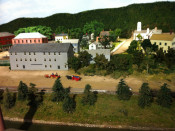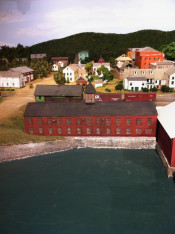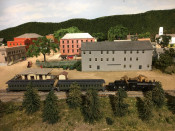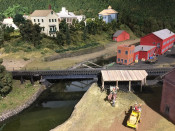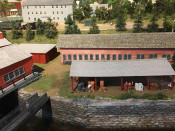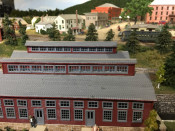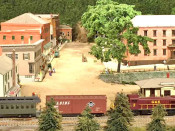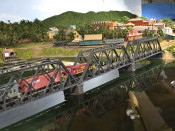The Canton Historical Museum houses two HO Scale model railroad layouts.
One layout is a 65-foot long diorama that depicts a portion of the Farmington River Valley beginning at a point north of Satan’s Kingdom, then running southward along the river to the extreme eastern part of Burlington. This area is modeled as it appeared during the first decade of the 20th century. The diorama focuses on the Town of Canton, and especially the Village of Collinsville, with replicas of key buildings and topographical features painstakingly researched and constructed according to early maps and photographs in the museum’s collections. Featured are the two railroads that served the town during the years when Collinsville was a bustling industrial center.
The second layout represents a typical New England railroad and the towns and countryside it served. Occupying approximately 1000 square feet of space, this model is freelanced, i.e., it is not a model of any specific real place or time. A point-to-point model railroad, it meanders through pastoral rural areas and gritty industrial sites as it connects its two major terminals, each of which has an extensive classification yard, turntable and roundhouse. Scenes depicting farms, quarries, logging operations, a power plant, small businesses, and even a baseball field await discovery by visitors.
Both layouts occupy the south end of the second floor of the museum, concealing the old Collins Company bowling alley once used by company employees. An exhibit that describes the history of the two railroads that once served the area is located on the wall opposite the diorama. This exhibit includes a brief history of each of the railroads, a large map of the region showing the old railroad routes, and historic photos dating to the era depicted by the diorama. Several railroad artifacts are displayed in the model room.
The Farmington Valley Railway Society (FVRS)
The museum is home to the FVRS, a group of railroad enthusiasts and modelers who meet every Thursday night (except holidays) at 7:00 p.m. Club members also operate the layouts during several special museum events throughout the year. When club members are absent a simple push-button control has been provided to enable visitors to see a typical train of the era run through the diorama.
History of the Model Railroads
The FVRS was organized in 1979, when the concept of a diorama of the Canton area was conceived by a member of the museum staff. She approached the owner of a local hobby shop devoted primarily to model railroading for help in bringing her concept to life. A plan for a diorama was developed with the museum staff, and drawings were prepared by one of the experienced model railroaders. Construction was begun early in 1979 by a group of about 50 volunteers, the charter members of FVRS. Not all of them had any experience in building a model railroad. Several modelers conducted classes to instruct the group in the art and skills of the hobby. Using materials generally employed in the hobby at the time (chicken wire and paper towels soaked in plaster for land forms, cardstock and bits of wood and paper for model buildings and bridges, hand-laid brass rail on individual wooden ties for track and switches) the team expended an estimated 30,000 man-hours of effort to complete the diorama and the freelanced layout. By 2005 both the diorama and the freelanced layout were beginning to deteriorate and no longer operated reliably. In addition, the availability of new materials and electronic technology made the older layouts obsolete. FVRS members totally demolished the freelanced layout and designed and constructed a new layout using state-of-the -art digital command and control technology that permitted several trains to run on the system independently and simultaneously. Rigid Styrofoam was used to build land forms. Track and switches employed prefabricated sections with plastic ties and nickel silver rail. Shortly after the freelanced layout became operational FVRS members began renovating and expanding the diorama, replacing the troublesome old hand-laid track with new prefabricated flextrack. Old deteriorated land forms were replaced with carved Styrofoam, and the old opaque river “water” was replaced with poured-in-place epoxy (which many visitors cannot resist touching to see if it is real water). Many of the old model buildings were refurbished, and many new model structures are being built for greater realism. This work is being done by FVRS members section by section rather than by total demolition to assure that the diorama, a favorite of visitors, would always be available for them to see. To learn more about FVRS visit www.fvrs.club.
For history on the railroads that traveled through Canton see our Railroads in Canton page.


